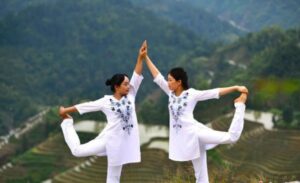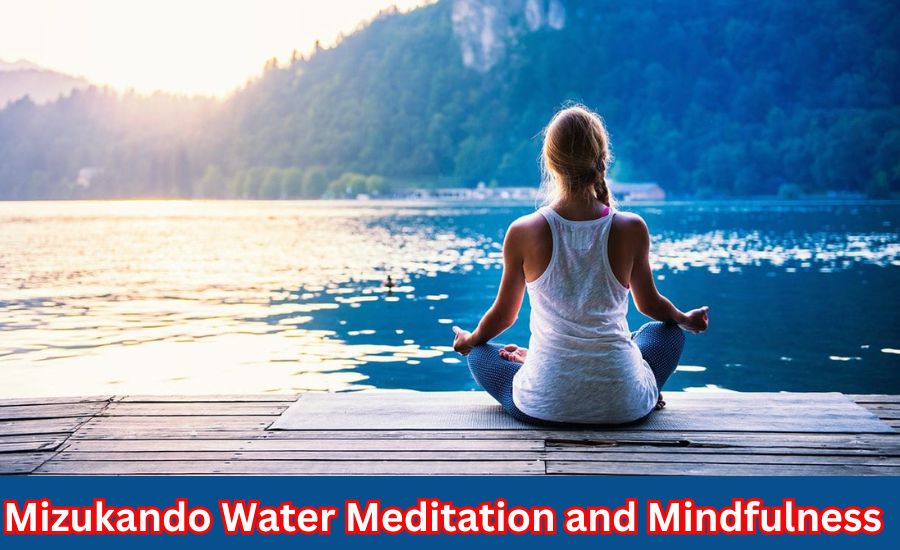Water has always held a vital place in the spiritual traditions of numerous cultures. In Japan, the tranquil practice known as Mizukando water meditation has developed into a distinctive method for achieving inner peace and balance. Whether you’re a nature enthusiast or a meditation practitioner, this ancient technique offers a refreshing path to deepening your connection with both nature and yourself. Let’s delve into the world of Mizukando and uncover how it can contribute to your overall well-being.
What is Mizukando?

Mizukando, also known as water meditation, is a traditional Japanese practice that focuses on cultivating mindfulness through the presence of water. Unlike other meditation techniques that often emphasize breath control or visualization, Water Meditation involves either immersing oneself in water or meditating near it to reach a profound state of tranquility and mindfulness. The soothing qualities of water enhance the meditative experience, offering a unique and effective alternative to more conventional methods.
How Does Mizukando Differ from Other Meditation Techniques?
Mizukando sets itself apart from other forms of meditation through its unique emphasis on water as a central element. While many meditation styles focus on breathwork or mental imagery, Mizukando integrates the natural calming effects of water to deepen the meditative state. This connection to water elevates the practice, providing a more immersive and peaceful experience compared to traditional techniques.
The Origins of Mizukando
The origins of Mizukando can be traced back to ancient spiritual traditions where monks and spiritual practitioners used natural water sources—such as springs and waterfalls—for meditation and purification rituals. These waters were believed to carry divine energy, offering a sacred pathway to spiritual enlightenment and a closer connection to the natural world. Over time, Mizukando evolved into a more structured practice, combining the therapeutic properties of water with meditation techniques to promote holistic well-being.
The Principles of Water Meditation
What Core Principles Guide Mizukando?
Mizukando, or water meditation, is grounded in several core principles that shape and define the practice:
- Mindfulness of Water: This principle emphasizes becoming fully present with the water. By focusing on the sound, sight, and sensation of water, practitioners anchor their minds, enhancing their awareness and deepening their meditation.
- Harmony with Nature: Mizukando fosters a profound connection with the natural world, encouraging practitioners to recognize the interconnectedness of all living beings. This connection with nature helps cultivate a sense of peace and unity.
- Purification: In Mizukando, water is seen as a symbol of both physical and spiritual purification. Practitioners view the water as a cleansing force, helping to clear the mind and body of negative energy and thoughts.
- Flow and Movement: Observing the natural flow of water serves as an inspiration for cultivating fluidity and adaptability in both thoughts and actions. This principle encourages a mindset of flexibility and ease, mirroring the effortless movement of water.
Benefits of Practicing Mizukando

Engaging in Mizukando, or water meditation, offers a range of benefits that contribute to overall well-being:
- Enhanced Mindfulness: The focus on water helps sharpen your awareness and presence in the moment, making it easier to stay grounded and fully engaged in the present.
- Stress Reduction: The soothing qualities of water naturally calm the mind and body, helping to alleviate stress and anxiety. The rhythmic sound of flowing water can be particularly effective in inducing a state of relaxation.
- Emotional Balance: Mizukando promotes emotional well-being by encouraging the release of negative thoughts and emotions. The purification aspect of the practice aids in cleansing the mind, leading to a more balanced and positive emotional state.
- Deepened Connection with Nature: Practicing Japanese Meditation Practices fosters a deeper appreciation and connection with the natural world. This connection can lead to a greater sense of peace, purpose, and harmony with the environment.
- Spiritual Growth: For those on a spiritual path, Japanese Meditation Practices offers a way to deepen their spiritual practice. The meditative focus on water, combined with the principles of purification and harmony, can facilitate spiritual insights and growth.
- Improved Flexibility and Adaptability: By observing the natural flow of water, practitioners learn to cultivate a mindset of fluidity and adaptability. This can lead to greater ease in handling life’s challenges and changes.
How Mizukando Enhances Mental and Physical Well-Being
Practicing Mizukando can significantly improve both mental and physical well-being in several ways:
Mental Well-Being:
- Reduces Anxiety and Stress: The calming presence of water, combined with focused meditation, helps to lower stress levels and reduce anxiety. This practice creates a serene environment where the mind can relax, leading to a more peaceful mental state.
- Boosts Mental Clarity: The mindfulness aspect of Mizukando sharpens concentration and focus, helping to clear mental clutter. This increased mental clarity can improve decision-making and problem-solving abilities.
- Promotes Emotional Stability: By engaging with the purifying element of water, Meditation Techniques with Water helps in releasing negative emotions and thoughts. This process leads to greater emotional balance, reducing feelings of anger, sadness, and frustration.
- Enhances Self-Awareness: Regular practice encourages introspection and self-awareness. This deeper understanding of oneself can lead to personal growth and a more profound sense of inner peace.
Physical Well-Being:
- Relieves Physical Tension: The practice of immersing oneself in or meditating near water helps to relax the body, relieving physical tension and promoting muscle relaxation. This can be particularly beneficial for those who experience chronic pain or stiffness.
- Supports Cardiovascular Health: The stress-reducing benefits of Mizukando can have positive effects on cardiovascular health. Lower stress levels are associated with lower blood pressure and a reduced risk of heart-related issues.
- Improves Sleep Quality: The relaxation and mental calm achieved through Mizukando can improve sleep quality. Better sleep contributes to overall physical health, aiding in recovery, immune function, and energy levels.
- Boosts Immune System: The reduction in stress and the promotion of relaxation through Mizukando can strengthen the immune system, making the body more resilient to illness and disease.
By integrating Mizukando into your routine, you can experience holistic improvements that enhance both your mental and physical health, contributing to a more balanced and fulfilling life.
Connecting with Nature via Mizukando
Nature-Based Meditation offers a profound way to deepen your connection with nature, enhancing both your spiritual and emotional well-being. Here’s how this practice helps you forge a stronger bond with the natural world:
- Immersion in Natural Surroundings: Nature-Based Meditation is often practiced in natural settings, such as by rivers, lakes, or waterfalls. These environments allow you to fully immerse yourself in the sights, sounds, and sensations of nature, fostering a deep sense of unity with the world around you.
- Mindful Observation: As you meditate, you become more attuned to the subtle movements of water and the surrounding environment. This heightened awareness helps you appreciate the intricate details of nature, from the ripple of water to the rustling of leaves, strengthening your connection to the natural world.
- Cultivating Gratitude for Nature: By practicing Nature-Based Meditation, you develop a greater appreciation for the natural elements that sustain life. The practice encourages you to acknowledge and honor the water’s role in nurturing the earth, leading to a more profound sense of gratitude and respect for nature.
- Enhancing Ecological Awareness: Regular engagement with water meditation fosters a deeper understanding of the interconnectedness of all living things. This awareness can inspire more eco-conscious choices and a commitment to protecting the environment.
- Spiritual Connection: Water is often seen as a symbol of life and spiritual purification in many cultures. Through Mizukando, you can experience a spiritual connection to the earth, feeling a sense of renewal and rejuvenation that transcends the physical experience.
By connecting with nature through Nature-Based Meditation, you not only enhance your meditation practice but also cultivate a lasting relationship with the natural world, promoting a sense of harmony and balance in your life.
May Also You Like: Fmybrainsout
Why is Nature an Essential Element of Mizukando?
Nature plays a crucial role in Purification with Water because the practice is inherently tied to the natural world. The presence of water in its natural state—whether in a river, lake, or ocean—serves as a powerful medium for meditation. Engaging with nature through Mizukando allows practitioners to:
- Reconnect with the Environment: Purification with Water fosters a deep appreciation for the natural world. By meditating in natural settings, practitioners become more attuned to the calming and restorative qualities of the environment, which enhances the overall meditation experience.
- Grounding Effects: Immersing oneself in nature during Meditation by Natural Water provides a grounding experience, helping to stabilize and balance the mind and body. The natural surroundings anchor the practitioner, creating a sense of rootedness and connection to the earth.
- Spiritual Connection: Nature, particularly water, is often seen as a sacred element in many spiritual traditions. Through Nature-Based Meditation, practitioners can deepen their spiritual connection to the Earth and its elements, experiencing a sense of oneness with the natural world and the life it sustains.
Incorporating nature into Nature-Based Meditation is not just a backdrop; it is an integral part of the practice that enhances its effectiveness and deepens the practitioner’s connection to both the environment and their inner self.
Getting Started with Mizukando
Embarking on your Mizukando practice is straightforward and requires just a few essentials. Here’s how you can begin:
- Find a Serene Water Source: Choose a tranquil location with a natural water source, such as a river, lake, or spring. If access to such a site is limited, a peaceful spot with a small fountain or even a water bowl can serve as a suitable alternative.
- Wear Comfortable Attire: Opt for comfortable clothing that allows ease of movement and relaxation. If your practice involves wading into the water, make sure your attire is appropriate for getting wet and remains comfortable throughout the session.
- Adopt an Open Mindset: Approach Mizukando with an open and receptive attitude. Embrace the practice with a willingness to fully immerse yourself in the experience and enjoy the process of connecting with nature and your inner self.
By following these simple steps, you can effectively start your Purification with Water practice and begin to experience its calming and enriching benefits.
Personal Experiences with Mizukando
Practitioners of Mizukando often find the practice to be deeply transformative. Here are some personal testimonials from those who have experienced its benefits:
- A Path to Tranquility: Hana, a dedicated practitioner, shares, “Mizukando has brought a sense of calm to my otherwise hectic life. The soothing sound of flowing water helps me center my thoughts and find peace amidst the chaos.”
- Enhanced Creativity: Kenji, an artist, reveals, “Incorporating water meditation into my daily routine has sparked new ideas and creativity in my artwork. The fluidity of water inspires and enhances my creative process.”
- Spiritual Growth: Aiko, a holistic wellness coach, notes, “Mizukando has deepened my connection with both nature and my inner self. It has been a profound spiritual journey, enriching my understanding and experience of the natural world.”
These personal experiences highlight how Mizukando can profoundly impact various aspects of life, from emotional tranquility to creative inspiration and spiritual growth.
Mizukando in Modern Times
In contemporary settings, Mizukando continues to be a relevant and enriching practice, adapting to the needs and lifestyles of modern individuals. Here’s how Mizukando is finding its place in today’s world:
- Urban Adaptations: With many people living in bustling urban environments, practitioners have adapted Mizukando to fit their surroundings. Small indoor water features, such as fountains or water bowls, offer a serene space for meditation within city apartments and offices.
- Integration with Wellness Trends: Mizukando is increasingly integrated into broader wellness trends. It complements practices like yoga and mindfulness, offering an additional layer of relaxation and mental clarity. Wellness retreats and spas are incorporating water meditation into their offerings, providing a holistic approach to well-being.
- Digital Resources: Modern technology has made Mizukando more accessible. Online guided meditations, virtual water soundscapes, and mobile apps offer resources for practicing water meditation anywhere, making it easier for individuals to incorporate the practice into their daily lives.
- Environmental Awareness: Mizukando’s emphasis on nature and water resonates with growing environmental awareness. The practice encourages mindfulness about natural resources and promotes a deeper appreciation for water’s role in sustaining life, aligning with current environmental values.
- Community and Sharing: Social media platforms and online communities have become avenues for sharing experiences and insights about Mizukando. Practitioners from around the world connect, share tips, and support each other, creating a global network of like-minded individuals.
By adapting to modern lifestyles and leveraging technological advancements, Mizukando remains a relevant and valuable practice, offering its timeless benefits in new and innovative ways.
The Future of Mizukando
As Meditative Practices in Japan continues to evolve, its future looks promising, with potential developments and expansions that could enhance its practice and accessibility. Here’s what might shape the future of Meditative Practices in Japan:
- Enhanced Accessibility: As technology advances, more tools and resources will likely become available to support Mizukando practice. Virtual reality (VR) and augmented reality (AR) could offer immersive experiences, allowing practitioners to engage with virtual water environments and guided meditations from anywhere in the world.
- Increased Integration with Wellness Practices: Mizukando may become more integrated with other wellness practices such as mindfulness, yoga, and tai chi. Combined practices could offer comprehensive wellness solutions, blending the physical, mental, and spiritual benefits of various techniques.
- Educational Programs and Workshops: As interest in Mizukando grows, educational programs and workshops may become more prevalent. These could be offered at wellness centers, educational institutions, and through online platforms, helping more people learn about and experience the benefits of water meditation.
- Sustainability Focus: With growing environmental consciousness, future practices of Mizukando might emphasize sustainable interactions with water. This could include promoting water conservation and educating practitioners about the importance of preserving natural water sources.
- Scientific Research: Increased scientific research into the benefits of Mizukando could provide deeper insights into its effects on mental and physical health. Research findings could validate and expand upon the benefits of water meditation, leading to greater acceptance and integration into mainstream wellness practices.
- Cultural Exchange and Global Spread: Mizukando may see further globalization, with more people from diverse cultural backgrounds incorporating water meditation into their own practices. This exchange could enrich the practice with new perspectives and adaptations.
By embracing these developments, Mizukando has the potential to continue offering its unique benefits to a broader audience while evolving to meet the needs of modern practitioners.
Conclusion
Mizukando, or water meditation, is a deeply transformative practice that integrates the soothing elements of natural water with mindful meditation. Rooted in ancient traditions, Water as a Meditation Tool offers significant benefits for mental, emotional, and spiritual well-being. It helps reduce stress, enhance creativity, and foster a profound connection with nature.
As it adapts to modern needs, Mizukando continues to thrive through urban adaptations, technological innovations, and integration with contemporary wellness practices. The future holds exciting potential for this practice, with advancements in virtual experiences, sustainability efforts, and broader educational opportunities.
In a world where finding calm and balance can be challenging, Water as a Meditation Tool provides a peaceful and grounding practice. By connecting with the natural flow of water, practitioners can achieve greater inner peace, emotional stability, and a renewed sense of harmony with their surroundings.
FAQs
Q: What is Mizukando?
A: Mizukando, or water meditation, is a traditional Japanese practice that involves focusing on the presence of natural water sources—such as rivers, lakes, or fountains—to achieve mindfulness and inner peace.
Q: How does Mizukando differ from other meditation techniques?
A: Unlike typical meditation practices that focus on breathing or visualization, Mizukando centers on the sensory experience of water, using its calming sounds and presence to enhance mindfulness and relaxation.
Q: Can I practice Mizukando in an urban setting?
A: Yes, you can adapt Mizukando to urban environments by using small water features like indoor fountains or water bowls. These can provide a similar meditative experience as natural water sources.
Q: What should I wear for Mizukando practice?
A: Wear comfortable clothing that allows ease of movement. If you plan to wade into the water, choose attire suitable for getting wet and ensure it’s comfortable.
Q: How often should I practice Mizukando?
A: The frequency of practice depends on individual preference and schedule. Regular practice, even if brief, can enhance its benefits. Many practitioners find that daily or several times a week works best for them.
Q: What are the primary benefits of Mizukando?
A: Mizukando offers benefits such as reduced stress, improved mental clarity, emotional balance, and a deeper connection with nature. It also promotes relaxation and spiritual growth.
Q: Can Mizukando help with anxiety?
A: Yes, Mizukando’s calming effect can significantly reduce anxiety. The soothing sounds and meditative focus on water help create a peaceful mental state, alleviating stress and anxiety.
Q: Is Mizukando suitable for beginners?
A: Absolutely. Mizukando is accessible for practitioners of all levels. Beginners can start with short sessions and gradually increase the duration as they become more comfortable with the practice.
Q: How can I incorporate Mizukando into my daily routine?
A: Integrate Mizukando by setting aside a few minutes each day for meditation near a water source, whether natural or artificial. Consistency, even in short sessions, can enhance its benefits and make it a regular part of your routine.
Read Next: Peniculs
